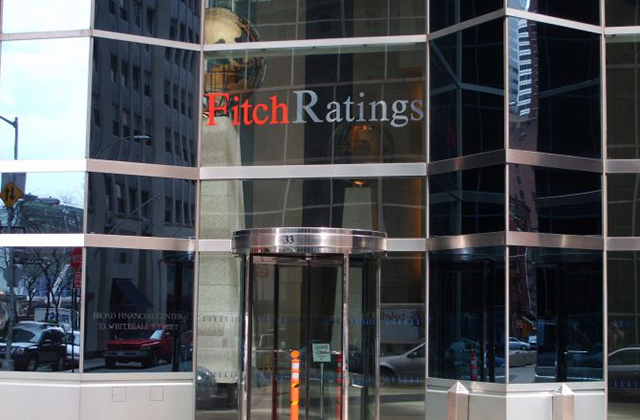
Fitch Ratings affirms Armenia at ‘B+’ with Stable Outlook

Fitch Ratings has affirmed Armenia’s Long-Term Foreign and Local Currency Issuer Default Ratings (IDRs) at ‘B+’ with Stable Outlook. The issue ratings on Armenia’s senior unsecured LongTerm Foreign Currency bonds have also been affirmed at ‘B+’. The Country Ceiling has been affirmed at ‘BB-‘ and the ShortTerm Foreign Currency and Local Currency IDRs at ‘B’.
KEY RATING DRIVERS. Armenia’s ratings are supported by higher income per capita, human development and governance indicators than peers, a credible monetary policy framework and the extended maturity profile of public debt. Conversely, the ratings are weighed down by high net external debt, high fiscal deficits leading to a rising debt burden, a highly dollarised banking sector and tensions with some neighbouring countries
Growth has weakened, as Fitch estimates 0.8% growth in 2016 reecting weak domestic demand, partly as a result of lower remittances inows. Growth will increase gradually in 2017 and 2018, reaching 2.1% and 3.1%, respectively, driven by the expected recovery in the Russian economy and moderate recovery in commodity prices. Fiscal consolidation in 2017 creates risks for Armenia’s recovery path.
The central government deficit rose to 5.6% of GDP in 2016, from 4.8% of GDP in 2015, and well above the initial 3.5% budget target. This was due to weaker revenues and increased execution of projects tied to external financing. It follows deficits consistently below government targets between 2011 and 2014. Fitch estimates Armenia’s public debt reached 56.8% of GDP in 2016, similar to the ‘B’ category median. Currency risk is high as 80% of government debt is foreign currency (FC) denominated, although the average maturity is long.
As government debt surpassed 50% of GDP in 2016, the government has to target a deficit of less than 3% of the previous three years’ average GDP to comply with the Law of Public Debt. The approved 2017 budget targets a deficit of 2.8% of GDP supported by revenues from tax code reform and reduced foreign-financed project execution. Fitch forecasts a higher deficit of 3.7% of GDP, as growth will recover only gradually and current expenditure is unlikely to decline relative to GDP. The authorities face the challenge of maintaining confidence in the sustainability of public finances while containing the impact of consolidation measures on economic activity, which could undermine revenue performance.
Armenia has shown capacity to absorb shocks and has a credible monetary policy framework. Annual ination remained in negative territory in November, at -0.6%, but should gradually move towards the central bank’s target of 4% in 2017-2018. In early December, Armenia completed the fourth review under the IMF’s Extended Fund Facility. International reserves rose to USD2.2bn (five months of current external payments). Fitch estimates that Armenia’s liquid assets as a share of short-term liabilities (at 125% in 2017) will remain below the ‘B’ category median (141%).
The current account deficit may have reached 2.1% of GDP in 2016 versus a ‘B’ median of 5.7%, balancing continued improvement in the trade deficit due to strong export performance and a slight increase in imports due to weak domestic demand against continued weakness in remittances. Current account deficits are forecast to average 4% of GDP in 2017- 2018 due to a subdued domestic demand recovery, the return of growth to Russia, increased export market diversification, moderate increases in international oil prices and the prospect of a new gold mine operation coming on line in 2018. A moderate deficit could also lead to a gradual decline in external indebtedness (net external debt of 48% of GDP vs peers’ 20%) after sustained growth in the aftermath of the global financial crisis.
Non-performing loans increased in 2016 (8.2% end- November based on the national definition of 1 to 270 days overdue), but the financial sector stabilised and made progress towards reducing vulnerabilities. Bank capitalisation strengthened (18.3% in 3Q16) in line with the central bank’s requirements, which are on target to be met by January 2017, mostly through shareholder contributions and with no need of sovereign support. FC credit and deposit levels remain above 60% of the respective totals. The banking system’s FX position is balanced and regulations are in place to prevent FC lending to non-FC generators.
As a result of the December 2015 referendum, Armenia is currently in transition from a presidential to a parliamentary system. The country will hold parliamentary elections in April 2017. Fitch does not expect material changes in the direction of economic policy. After the short-lived armed escalation in April 2016, the ‘frozen’ conict with Azerbaijan regarding the disputed Nagorno-Karabakh region has returned to its previous state of low level sporadic clashes.
SOVEREIGN RATING MODEL (SRM) and QUALITATIVE OVERLAY (QO). Fitch’s proprietary SRM assigns Armenia a score equivalent to a rating of ‘B+’ on the Long-Term FC IDR scale. Fitch’s sovereign rating committee did not adjust the output from the SRM to arrive at the final LTFC IDR.
Fitch’s SRM is the agency’s proprietary multiple regression rating model that employs 18 variables based on three year centred averages, including one year of forecasts, to produce a score equivalent to a LTFC IDR. Fitch’s QO is a forwardlooking qualitative framework designed to allow for adjustment to the SRM output to assign the final rating, reecting factors within our criteria that are not fully quantifiable and/or not fully reected in the SRM.
RATING SENSITIVITIES. The Stable Outlook reects Fitch’s assessment that upside and downside risks to the rating are currently balanced. Nonetheless, the following risk factors could, individually or collectively, trigger positive rating action:
– A downward trajectory in the government debt-to-GDP ratio.
– A sustained improvement in the external balance sheet. The following risk factors could individually or collectively, trigger negative rating action:
– Continued increases in the government debt to GDP ratio due to a failure to implement fiscal consolidation measures and/or growth underperformance.
– A marked drop in foreign exchange reserves.
Fitch assumes that Armenia will continue to experience broad social and political stability and there will be no prolonged escalation in the conict with Azerbaijan regarding Nagorno-Karabakh to a level that would affect economic and financial stability. Fitch assumes that the Russian economy will grow by 1.3% and 2.0% in 2017 and 2018, respectively.























